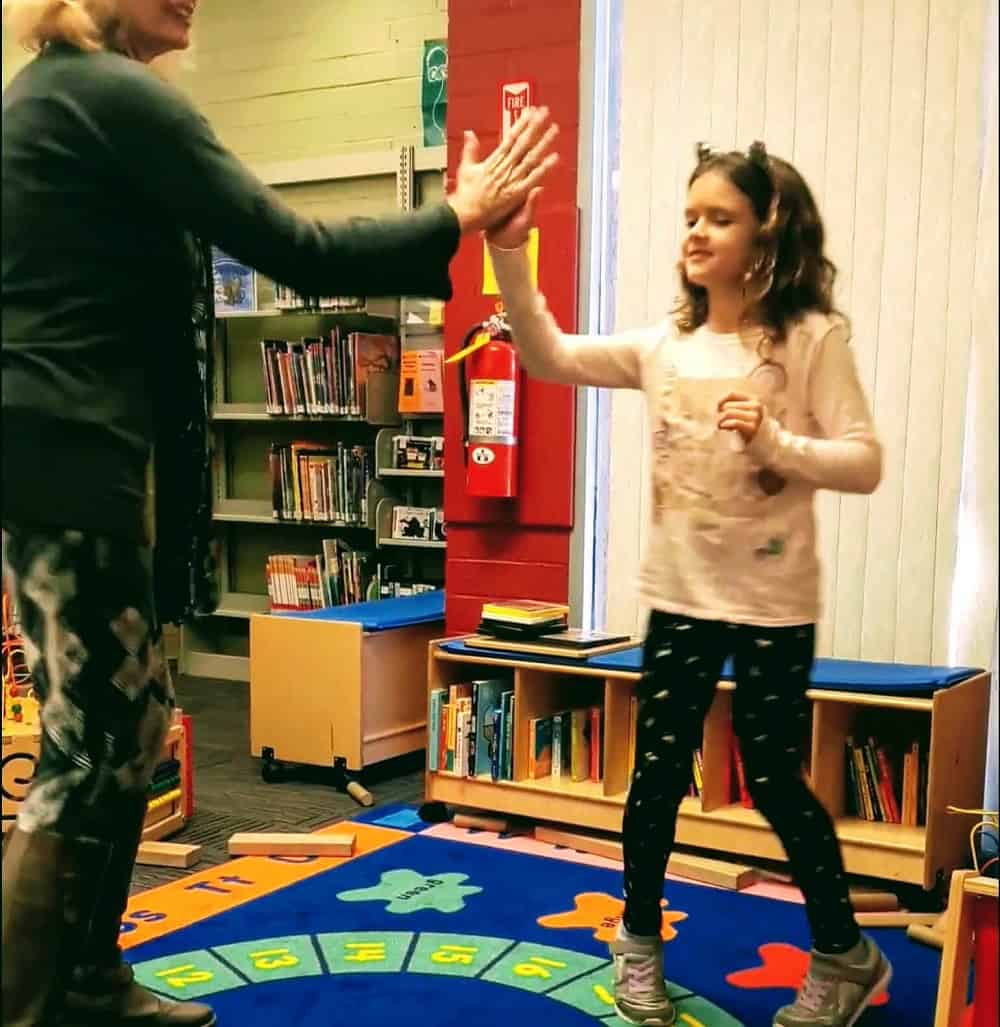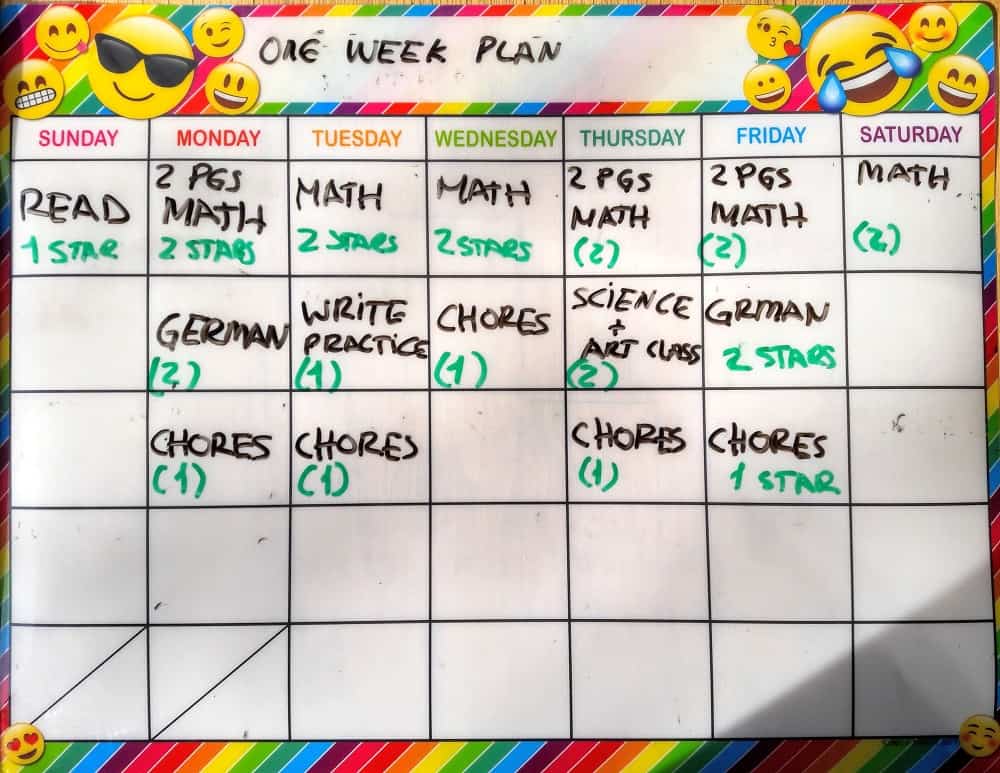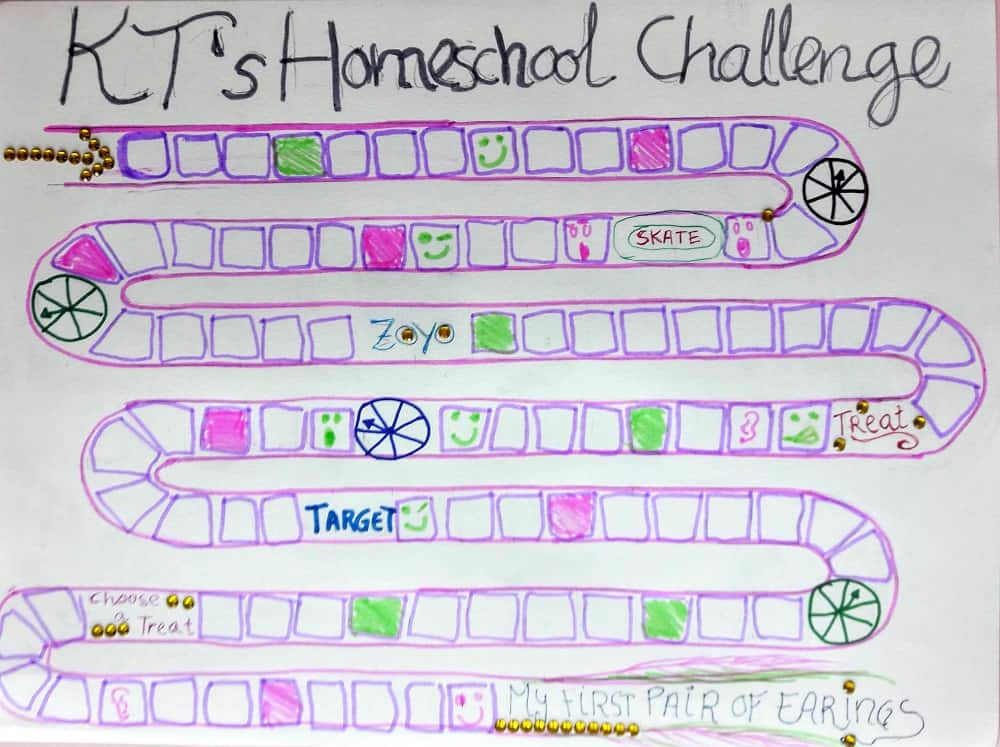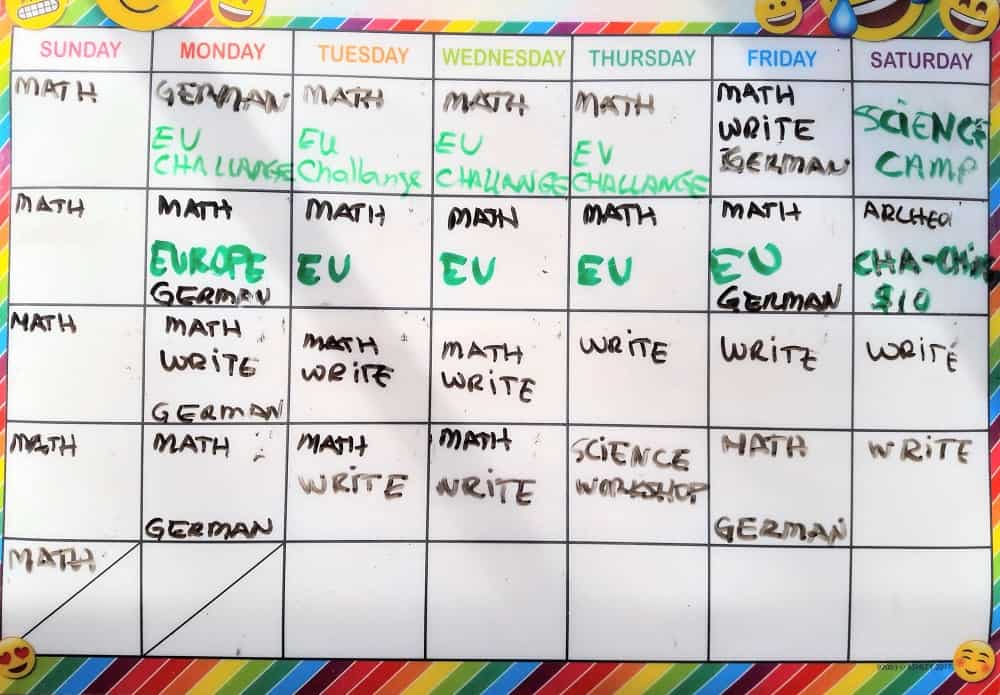
The problem is that as parents we start off from the premise that not having to go to school should be incentive enough for our kids to want to homeschool and do the work. Whilst our kids seem to be unappreciative of that fact and simply can’t get excited about doing homeschool work. Specially the kind of homeschool that typically happens at the kitchen table -core curriculum stuff.
With homeschool parents specially, I think, wanting our kids to embrace the learning is almost more important than that they get their work done. So we don’t want to punish, or pound them with memorizing, threaten, give ultimatums, threat with putting them in school, and use techniques that get kids to hate doing homeschool work. Sometimes, we feel that homeschool is not a good fit for our child. But it helps to see it from the kid’s perspective. “Why should I do boring math sheets or writing when I can play or watch YouTube?” This realization was always there but I never acted on it. Until I realized that I needed to push myself a little harder…if I could design and project-manage games for LeapFrog, I could certainly come up with a fun and rewarding way to make our homeschool work more palatable.
The truth is that unless your kid is very easy going, homeschool can be a war no parent, specially homeschooling parents want to fight.
If homeschool is boring, and they don’t want to do it, it is probably resembling school without the social and challenging aspect. In other words: insipid and lame.
Here are some ideas that I learned along the way to motivate my willful homeschooler. But before I go on, please let me emphasize that whatever learning agenda you have it is better if it is presented when the child is developmentally ready.
Make it FUN, make it CHALLENGING, and make it REWARDING
THE HOMESCHOOL CHALLENGE
The following tips work for us, but are not a one size fits all, you can change them to your child’s interests, your means, and your parenting style. Boys will want different themes and rewards, also, I would not do this if my daughter was younger than 7 years old. We started when she was 8.
The Homeschool Challenge is comprised of three components:
1. The weekly board

I use a dry erase board that is divided into boxes for each day of the month. At first I didn’t use the board as a month board but as a weekly task board. Why? This is important: You can customize each week based on what you learn the previous week. I could be too ambitious with what my daughter was able to take on each day or I could be too modest. I wanted to fine tune scheduling the daily tasks so that we could get to a place where she was comfortable and could take it on herself. The board has the days of the week in large and clear font, and it is divided in nice big boxes. I use the board as a weekly planner for classes / homeschool (at home) / and chores. I plan from Monday through Sunday. Each task was on it’s own box in nice big letters so she could read and identify easily. Each task had points or stars associated with it. So that each day she should win a total amount of starts.
Note that we put tasks on every single day of the week. For one reason, I figure we could do a little everyday vs. trying to pack everything in 5 days. For another reason, I couldn’t afford to take days off and lose continuity. Stars could be acquired every day of the week!
2. The game board

The game board was designed to last at least a month. It looks like a board game, or long maze divided into little boxes for each star won. Along the way there are little milestones, or goals, the child can get to. You may find that your child really wants to reach a certain goal. Like they really really need that gallon of slime glue, and they will do bunch of homeschool to add up the stars to reach that goal faster. This is when you see it’s really working!
In our challenges the goals are almost always different. The Homeschool Challenge and game-board are themed. The Endgame is the final price. We had an LOL Doll Challenge the first time. The milestones along the way were TREATS, SURPRISE, EAT AT HER FAVORITE RESTAURANT, ETC. The final price was an LOL Doll.
3. Star stickers
Every time your child finishes a task from the board, for example “Math” is one star per page , the child will stick the star stickers on the Game Board. And so on until they get to a milestone (a treat, a surprise, go to the movies, etc.)
Optional:
The Wheel of Fortune: This just adds FUN factor. I put a logo of a wheel of fortune in places along the Game Board to make it more fun. I made a wheel of fortune with a fidget spinner and a circle on a board. I divided the circle into fun things I know our daughter likes. We had: Ice-cream, Get a Treat, Dollar Store, Restaurant, Spin again, Movie, etc. Ever since, she and her friend decided to make one themselves with foam-board and a small fidget spinner. You get up to 3 spins and get to chose one result.
Once the challenge is complete and she reached the Final Price on the current challenge, we get together and determine the theme of the next challenge and what the milestones might be and what the final price will be.
Your child can pick something he really wants! The way we did it was that when our daughter asked for something like getting her ears pierced. I would say, OK, let’s make that our next Homeschool Challenge. After a while she started designing her own challenges and they were great! She had an Our Generation Doll Challenge, a Slime Challenge (where all the milestones were glue), etc.
The Homeschool Challenge works because it encompasses FUN, CHALLENGE, and REWARDS.
It also works because it established a routine for the child to do her homeschool everyday. We only reward on completion, not on how well she does the work. There is no grades, it’s either right or wrong, completed or not completed. In other words, the work is completed well or no stars are awarded.
This game also gives the parent the flexibility to change things up, according to how you see your child responding.
NOTE: We give points for “Projects”. We don’t specify the project ahead of time. We think projects are some of the most innovative, creative and involved part of our daughter’s homeschool so we leave it up to her. Or up to necessity. For example, recently she needed a hair dresser chair for one of her big dolls, so I suggested she make one with some wood scraps and nails we had around. It was hard, I helped some, but she owned it. And it was done. That in my view was a project worth 3 Stars.
But, Isn’t It Wrong To Reward Learning?
Some will say: “If you reward learning and doing homeschool, Where will it end? If you reward every homeschool task, chores, projects, etc. the child will just EXPECT to get rewarded.”
In my experience implementing this reward system and making homeschool work challenging and fun has lead to my daughter learning that she is expected to do the work and she has a positive association to doing homeschool everyday. She has discovered that Homeschool is not as boring as she thought, and she has realized that she is very good at math and other skills she didn’t know she had.
It has been 8 months since the Homeschool Challenge, and now we don’t even do a reward system.
Expecting the child to want to do the work because her reward is the work is unrealistic.
Unless your child, willful or not, loves to do chores, math, writing, worksheets, etc it would be unrealistic to expect her to do it for the love of it.
Here is the long answer: School teachers implement reward systems in the classroom. Challenges, competitions…sometimes the rewards are tangible sometimes it’s to be “line leader” for the week. Or to be “teacher helper for the day”, etc.
Adults learn that our time is valuable and our efforts shouldn’t go unappreciated. We don’t go to work and expect not to get paid. If there was no incentive for adults to do the work, we wouldn’t do it. Why should we expect kids to do that?
If you think about it, try to think of things, treats, prices, toys, activities that you have awarded your child simply because you think they need it at the end of the week, or because they worked so hard. Or because they are so well behaved. We constantly justify to ourselves why we get stuff for our kids and how we can position it for them so they don’t grow up spoiled. With the Homeschool Challenge you simply save those treats, toys, special prices and turn it into a game that ends up being win-win.
Soon enough the kids will own their challenge and put on the board what they really wish to earn, or get.
Another Variation on the game when change is needed

Once the child had done the homeschool challenge as described above and it’s working. Thas is, she has developed a routine, and has gotten used to the idea that homeschool is to be done everyday. You can graduate to a more simple way to track the achievements: On your dry erase calendar mark all the days of the month and the tasks to be completed each day (instead of planning by the week). By now your child knows how many stars she will get for every task and can add them all up or multiply or stick stars on each day and then add them all up at the end of each week for a reward. So no Challenge Board is needed. Just the monthly planner dry erase board.
In addition to that, I started adding a “Cha-Ching Challenge”. Because with an unmotivated homeschooler you may only get to focus on two or three subjects at the most, you may find that you never seem to get to subjects like History, Geography, etc.
In our case when our daughter was 8 years old, we could only focus on Reading or Writing Practice and Math at home everyday, and in addition to that she had German twice per week and Science&Art workshops twice per month. I also made sure I put “Chores” on there, so develop a habit and expectation of doing chores. That’s all I could stretch it without making her life miserable. The rest of the time, she could focus on her own interests, whether it was slime making, or other projects.
The Cha-Ching Challenge came about because she wanted to make money. I’ve put on the calendar different topic challenges and attach to them a dollar (or Euro depending where we are) value.
The European Cities Challenge
This challenge was worth $10. A project where she had to be able to identify Europe on the globe, answer questions about it, find a map of Europe and identity the countries, and learn the name of the capital cities. And find ways to learn it. Note: We had already learned the continents, oceans, and other fun facts about our planet…
The Winter Solstice Challenge
This one is worth $20. At the end of this challenge which I assign about a month to get ready for, she has to answer a bunch of questions like What are the continents, What oceans are on either side of America. Which country borders the US on the north…. What are the meridians. How long does it take for the Earth to spin once on it’s axis? What is latitude. What is longitude. Where are the Tropics. Which hemisphere do we live in.Etc. And then explain how the Earth would be in Winter Solstice and how it would be positioned in relation to the Sun.
We have a Winter Solstice Party every year and invite other kids to share in this lesson and do crafts related to this day. I have a Natural Geography Guide for Kids 5 – 8 that may be of interest.
The Children’s Business Fair
This is a one time event that happens in our town, where kids get to sell their products or services in one place for just one day. It requires kids to come up with an idea, develop it, and produce enough product to sell on the day of the Fair. We use it as a hands on project that encompasses: commitment, vision, planning, her 3rd grade math problems, art, etc. The final price is as much money as she makes on the day of the Fair (minus her expenses.)
Other Ways I Used To Make Homeschool Work Fun
The Grammar Games
The Sidewalk Game
We play this on the driveway, buy it can be played anywhere where you can draw with chalk on the pavement.
Write pronouns and personal pronouns on the driveway or sidewalk with chalk.
Call out “pronoun!”
The child has to skip on a word that is a Pronoun. And while on one leg standing on the type of word, she must make a sentence using that pronoun.
Repeat calling out “personal pronoun!”. And do the same.
And so on.
Add verbs and adjectives as they get good at the pronoun/personal pronoun game.
Once you have added pronouns, verbs, articles, adjectives, the game gets more challenging as kids have to skip to make a sentence. Sometimes a crazy sentence.
Grammar Card Game
On flash cards, write 10 adjectives, 10 present tense verbs with regular verbs and irregular verbs (for example: walk, play, eat, break, take, go, shake, feel, make, choose) , 10 nouns. Then write the Present, the Past, and the Progressive tense. Total 60 Cards. It’s kind of like Go Fish. This is a card game where you want to make sets of three cards. In the beginning you can make sets of 3 Progressives, 3 Presents, 3 Past tenses (they don’t have to be of the same verb). 3 Adjectives, 3 Nouns or 1 Presnt, 1 Past, and 1 Progressive and 1 Adjective 1 Noun, 1 Verb. The player who can gather four sets first wins.
Player 1: Do you have any past tenses?
The player who has been asked has more than one Past tense, she will relinquish all the Past tenses she has. if not: “No, Go Fish.” and Player 1 must take a card from the stack.
Etc.
The players might decide to change the rules to make the game more challenging once they got the hang of the game. Such as: making sets with the same verb.
You can modify this game to contain the whole list of irregular games and no adjectives and nouns. You can modify to be nouns, adjectives, adverbs, etc. Or Personal pronouns, verb persons, etc.
Please see our post on How To Homeschool 1st Grade or
THE GEOGRAPHY GAMES
This game is played with your globe. The inflatable globe ball is awesome because it’s easy to handle and you can throw it over to the next player, or back and forth if you are playing with just one child.
Each player has to get 3 answers right. There are 5 chances.
Ask questions from the the Natural Science Guide I:
Show me Australia
Where is the North Pole?
Who’s is the South Pole?
Show me Europe:
You can give tips like “Look in the Northern Hemisphere.” “France, Spain, Germany are in it”. Etc.
Which Ocean is between America and Europe?
CORE LESSON:
Point out that the Southern and Northern Hemispheres are divided by the EQUATOR.
Ask if they can find the equator Equator.
Play this game back and forth as long as they want. Let them have fun with it.
My daughter asks me about the tiniest countries and islands she can find on the globe to make me miss. She loves to see me struggle and miss my points.
Give points even if you have to help her a little but gets it right. If they need too many clues, just move on to the next question. And during another turn ask the question they missed before.
You can play this game as often as possible, but don’t make it seem like a chore. Geography is fun!
Lesson 2 The Birthday Calendar
Review the four seasons and where we are in relation to the sun during the different seasons.
CORE LESSON: Conceptualizing the Earth in relation to the Sun and how the positioning of the Earth and the tilt is the reason for the seasons, food, birthdays, weather.
Draw a Sun. Mark the solstices:
Then mark the birthdays on the months in between the solstices.
Ask them how old they are, and how old their friends are down to fractions: 8 and 1/2, 8 and 3/4, etc.
Talk about what the weather is like during the seasons and why that is in relation to where the sun is and how much sunlight plants, oceans and land masses are getting…
Other ideas:
Best Homeschool Math and How to Help Your Child Learn It
Project Based Homeschooling – 43 Project Ideas
How to homeschool First Grade and Second Grade or 6 to 8 year olds
Ways to help my child learn entrepreneurship
What If My Child Doesn’t Want To Learn From Me?
It’s not that kids don’t want to learn from their mom, it’s that they don’t want their mom’s to teach them. More often than not I hear moms tell me that their kids don’t want them to teach them.
I didn’t have a 5 year old that asked to read, much less to teach her to read. In fact, when she saw that I had an agenda, she stopped asking me to read to her at night. I didn’t have a kid who liked worksheets. My daughter didn’t just explain to me that she didn’t want to go to school, but she went as far as to explain how she felt when she was at preschool or with a babysitter, away from mom. So in order to protect her feelings, cherish her personality and still keep a standard of education, I had to get creative.
I knew she didn’t have any learning disabilities it was simply too boring and uninteresting to sit and learn to read, or learn math.
We waited until she was old enough to grasp and learn these subjects and in fact she was able to learn everything at a basic level in 6 to 8 months. But it was like pulling teeth to get her to do the work, sit down and focus.
In time, we of course, understand that kids that have never been to school don’t have a benchmark to compare to. The only thing they really understand is play and connection. Finding a curriculum is not enough, it’s really only up to the parents to find a way to make school work fun, creative, challenging, and rewarding.
